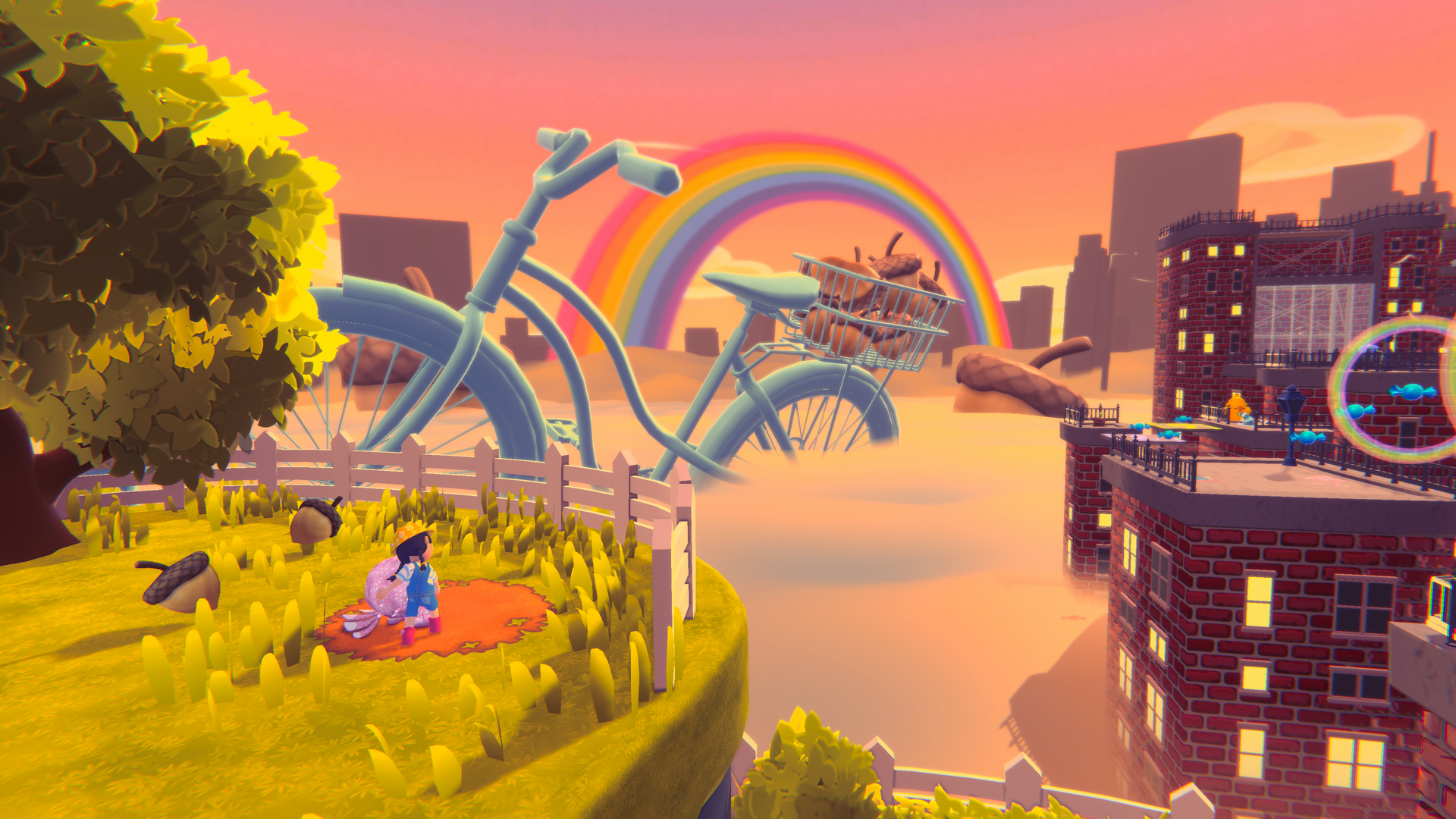Sprouting Spirit: Dream Duo is a 3D puzzle platformer that takes you on an adventure through the fantastical world of Maple’s imagination. As a new resident in the bustling city, Maple is afraid and overwhelmed and seeks solace in her own imaginary world. But alongside her new imaginary friend Cornelius, she’ll learn to overcome challenges and face her fears.
Our senior project team created a game project as well as the animation project (check out my CFX work on the animation project here)
My Responsibilities
A lot went into this project, so I’m breaking this post into 4 sections based on my key roles. Feel free to click on the links to skip to section
Concept Art & Level Design
I worked on both the game and animation’s concept art. I will be sharing some exploration concept sketches that defined Maple and Cornelius, our protagonists in our animation and video game.
Maple is a young girl who recently moved to a new city and is overwhelmed by the environment. In the concept art, I





Once we were happy with the design directions for the animation side, we turned our concept art efforts into designing a simplified version of the characters for the video game.



We then outline how we want our environment to look like. Since the game takes place in the imaginary world, we decided to have the first level based off the garden from the animation, then go wild the rest of the levels. I spearheaded the art direction and design for the first part of the game to set the tone before I move on to working on the animation.




Lesson Learned
Believe it or not, this was the first projects I worked on environment concept art. It was a challenge for me, but using references really helped, and getting near-instant feedback from my team on Discord is invaluable. I was able to send my rough pass and get a respond from someone (or a few people) within seconds!
Shout out to all my teammates! Check out their profiles through our team website!
Animation
I ended up being responsible for almost the entirety of the main characters’ animation for the video game. I also worked on some of the enemies’ animation, but those are pretty minimal.
In the first stages, while we were figuring out mechanics and interactions, I sketched out these 2D animation to visualize them interacting to understand the rigging requirements and to make sure things don’t look weird.

From there, I worked with the riggers to make sure my animation needs were met. (Shout out to Erika for Maple’s rig and Daniel for Cornelius’ rig)

Here are the final animation! I put them on Sketchfab so you can browse them at your own leisure! It should let you browse through different animation clips.
Dialogue System and Narrative Design
Since our game needed a story arc to build the characters’ relationship, I designed designed and implemented the dialogue system using the same framework as the screen-space framework to keep texts clear and legible, as well as flexible to edit.

The dialogue is triggered based on location of the characters and their locations. Through multiple playtesting sessions, I made sure the fix the dialogue systems to ensure it is not obtrusive toward the gameplay, while still help convey the narrative the story.
Lessons Learned
The dialogue gave a very specific challenge in UX. We wanted to make sure the gameplay takes priority and did not want to disrupt the player’s flow. By creating a screen-space dialogue that doesn’t stop players from continuing the game, we faced the challenge of moving characters and off-screen characters.
I learned from this process to keep the text minimal to prevent players from ignoring the dialogue altogether. We stuck with the Closed Captioning (CC) rule to keep text limited to 1-2 lines, with 32 characters or less on each line.
To further limit obstruction to gameplay, we also dynamically move the text around depending on where the character stands. The dialogue lines stay at the
Furthermore, adding the animation effect on the text pop-up significantly increased player’s engagement. Without it, players sometimes miss the dialogue that occurs at the edge of the screen if they are focused on a task.
Playtesting
During Winter and Spring Quarter, we did a lot of playtesting to ensure best player’s experience. Our team members worked hard to find pain points in the game. We used the playtesting data to ensure the best player experience and to make adjustments to level design that cause players to be confused or get frustrated.


One of the frustration points was in level 3. where player had to hike up to the top of a platform. The two pain points in this area were 1) the puzzle was hard to understand and 2) if the player falls from the top, they have to go through the tedious motions to get back up to the top again.
From this findings, we asked the level designers to add check points that allows player to get back to the top without having to climb their way up. For the puzzle, we continued to iterate through different methods to make it clear to the players what they CAN do without giving the puzzle away. It was a balance that we had to keep, but through iterations and A LOT of playtesting, we can to a happy balance that keeps the players engaged, while allowing multiple solutions and many AHA! moments.
Lessons Learned
I don’t think I need to say this, but playtesting is crucial to game development. We received so many valuable insights from players who have never played the game before. I’m super thankful for our team, especially Sam, who tirelessly make a build (and doing all the bug fixes so the build can run) every week so we get new content to test out. It was a lot of hard work, but it’s all worth it.






